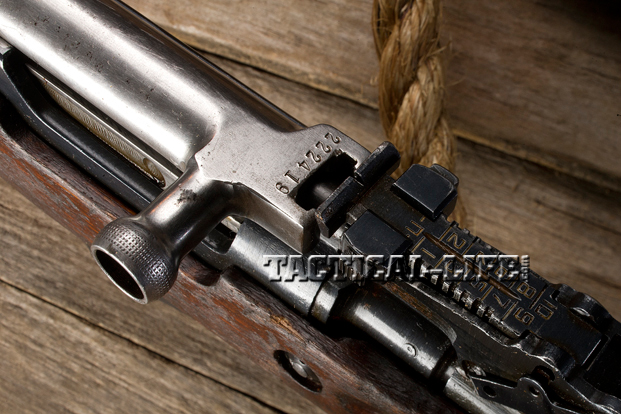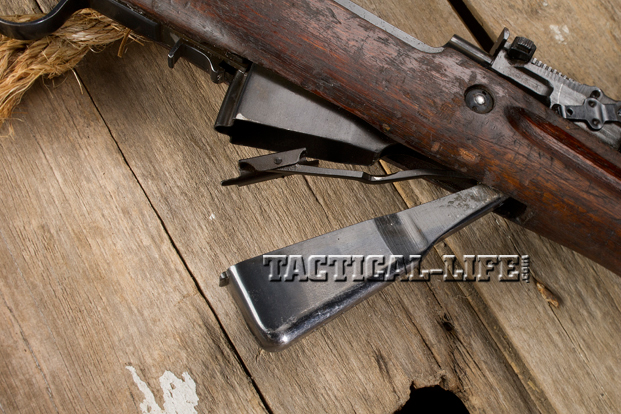When it comes to 20th century Soviet-era small arms, the 7.62x39mm AK-47 may be the weapon that first comes to mind. But the classic Samozaryadnyi Karabin Sistemi Simonova (known to most collectors and shooters simply as the SKS) deserves an equally respected spot of honor. While the SKS rifle did not achieve the long-term iconic success of the AK-47, it was an extremely capable and advanced rifle for its time, serving around the world well past the point of the AK’s introduction.
Developed by famed firearms engineer Sergei Gavrilovich Simonov, the SKS was the result of a new approach to not only small arms design but also cartridge configuration. Beginning in the late 1930s, the Soviets set about developing what we would now term an “intermediate cartridge,” concurrent with the efforts of the Germans who were developing their 7.92x33mm round. Upon its appearance, the new Soviet cartridge was dubbed the M43 (to indicate its year of appearance). Eventually becoming the 7.62x39mm we know today, the M43 found its home in a self-loading carbine Simonov had developed, which featured a 10-round magazine and a folding bayonet. Produced in 1944 and sent to frontline troops for battlefield testing, the carbine proved to be a hit with the Soviet troops (no doubt due to its low recoil and semi-automatic operation). Simonov continued refining and perfecting the design after the war’s end, recognizing that it could still serve an important role with the Red Army. The resulting weapon was the SKS. However, the SKS’ days as a frontline military rifle were numbered, as the detachable-box-magazine-fed AK-47 would soon take its place. Despite this, the SKS went on to serve with Communist and aligned forces worldwide during the Cold War and was produced outside Russia in such locations as Romania, East Germany and, as a result of early Sino-Soviet amity, even the People’s Republic of China, where it was produced as the Type 56.
Heart Of The Machine
Although the SKS and AK share their chambering and certain general characteristics, the SKS is both operationally and materially different from its more famous sibling. The AK employs a long-stroke gas-piston system, with the piston attached directly to the bolt carrier. But the SKS employs a short-stroke piston system. In this system, gas is tapped off a port in the barrel located at the forward gas block, 6.75 inches back from the muzzle of the carbine’s 20.25-inch barrel.
Advertisement — Continue Reading Below
As the gas is tapped off the bore, it strikes a 9.5-inch-long piston rod located inside the SKS’ gas tube, which is driven rearward to impact against a spring-loaded 3.25-inch-long piston extension inside the gas piston base, below the rear sight. This piston extension is then driven back to strike against the forward inner face of the bolt carrier. The force of this impact causes the bolt carrier to move rearward and unlock the tilt-locking bolt and cycle the action. At the same time, the spring-driven short rod resets both itself and the longer piston rod to its forward position. Operationally, the SKS fits neatly into the Soviet approach to weapon design—namely that simpler is better. The safety is a lever located to the right side of the triggerguard. The carbine features a hinged fixed magazine that holds 10 rounds of 7.62x39mm. To load the rifle, simply lock-open the action and either handload single rounds directly into the magazine through the ejection port or feed them in via stripper clips with a stripper-clip guide that is (in most cases) integrated into the bolt carrier. A magazine release lever is located forward of the triggerguard and can be used to hinge open the magazine base to empty the carbine. The follower of the magazine locks open the action when the carbine is empty. The SKS features an integral folding bayonet system located under the barrel. To fold open the bayonet, pull back on the spring-loaded and knurled section behind the barrel-lock ring and then swing down the bayonet. It travels in a 180-degree arc to a forward position. The barrel-lock ring is relieved on its rear upper face to allow it to “snap” over the muzzle of the barrel. The mounting link of the bayonet has a spade-style shape that features two locking ledges—one at the rear and one at the front. These allow the bayonet to lock solidly in both the open and closed positions. The sights of the SKS should be familiar to those accustomed to Soviet weapons. The rear unit is a sliding tangent notch rear with range markings (usually out to 1,000 meters), and the front sight is an elevation-adjustable hooded post. Those who have fired an AK with iron sights should feel reasonably at home with these.
Type 56
Although SKS carbines are generally becoming rare on the market, the Chinese variants (due to misguided import restrictions on Chinese military arms) have become quite difficult to find. So when I saw that Century Arms had located a small batch of Chinese military Type 56 SKS carbines, I jumped and put in an order immediately. As a caveat, the rifles as listed were available in a variety of conditions. These ranged from “poor and incomplete” to “good with cracked stock.” Obviously, none of these were going to be museum quality, but considering their relative rarity these days I was perfectly fine with the situation. So, my order went in for one rated at the best condition available.
The Type 56 I received was just what I expected. The stock of the carbine was gouged over much of its surface and had significant portions of finish worn away. However, it appeared to be free of any notable cracks or severe damage. The metal on the carbine was a mixed bag. There was heavy wear on all the sharp edges with scratches all over, but the metal was mostly free of rust (except for a few spots on the right side of the gas piston base and on the barrel below it). Strangely, the tip of the bayonet was bent as though the rifle had been dropped on it when it was deployed. All serial numbers on the carbine matched.
Referencing the excellent book The SKS Carbine (CKC45g) by Steve Kehaya and Joe Poyer, I set about researching the provenance of this SKS. I quickly determined it was an early production gun, featuring a milled triggerguard and a threaded-in barrel. It also features a chrome-lined barrel, which had helped keep the condition of the bore quite good. Using the book’s reference guide on Chinese Type 56 SKS manufacturer codes, I located a “26” inside a triangle and determined that the rifle was manufactured at Factory 26 (Jianshe Arsenal), located in the city of Chongqing. The serial number on the receiver had a “3” preceding the primary serial number that matched throughout all the parts on the rest of the SKS. According to Kehaya’s and Poyer’s book, this indicated that my SKS was built in the third year of production, which was 1959.
Advertisement — Continue Reading Below
As an enthusiastic collector of SKS carbines, I came away from this purchase very happy. Is it in exquisite condition? No. Do I like the importer marks on the barrel forward of the stock that are required by law? Not really. But the fact that I have now added an early-era Chinese Type 56 to my collection more than outweighs any of these issues. One of these carbines would make a fine addition to a dedicated SKS collector’s or even the fledgling beginner’s stable. For more information, visit centuryarms.com or call 800-527-1252. For a copy of Kehaya’s and Poyer’s book, visit northcapepubs.com. ★

































